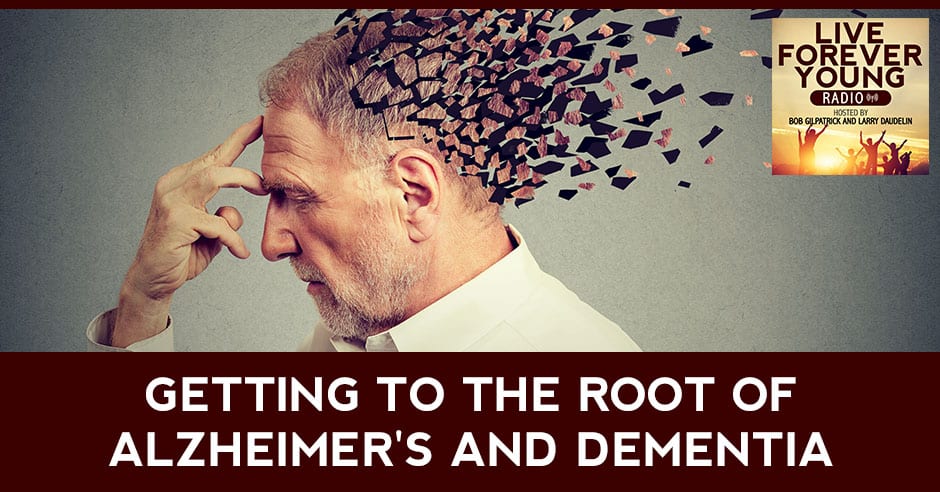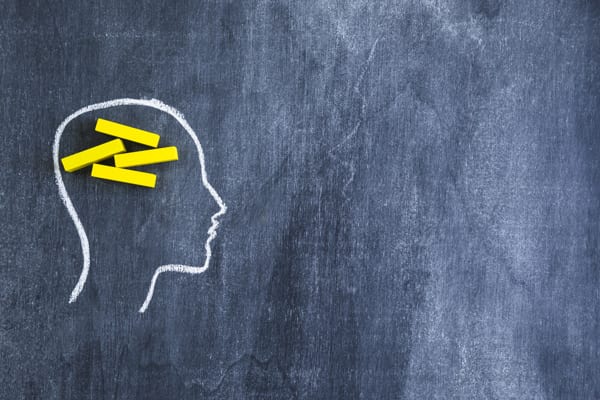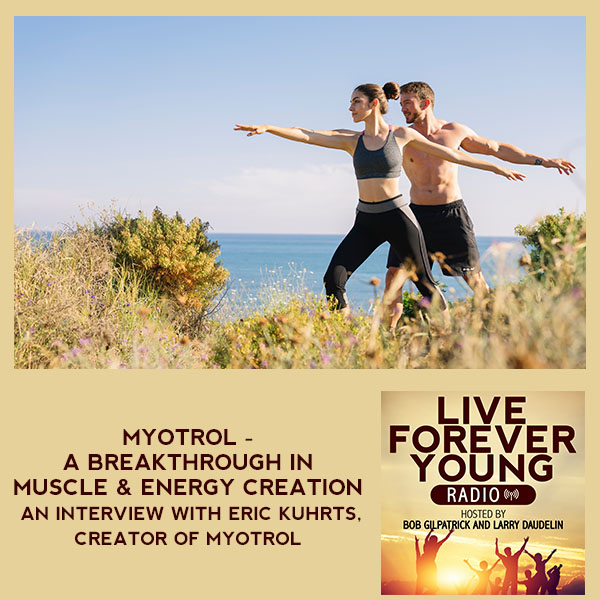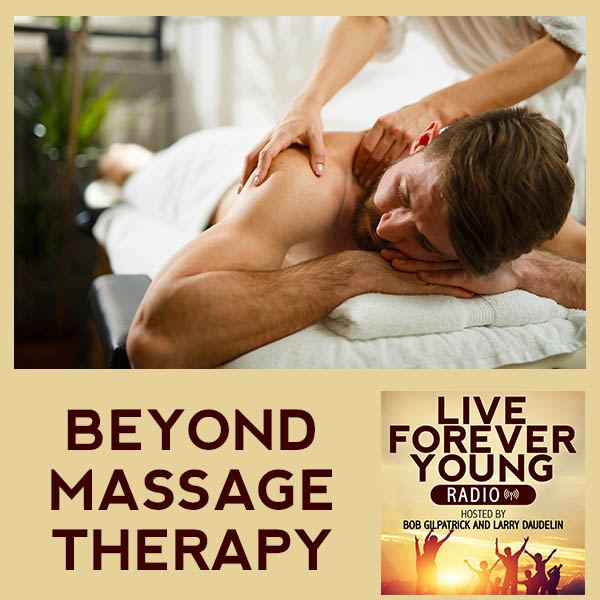
Did you know that over 6.2 million Americans have Alzheimer’s disease? Join Bob Gilpatrick and Rollie Culp as they delve into the different causes of this disease. The FDA has recently approved a first-of-its-kind Alzheimer’s treatment that targets the fundamental pathophysiology of the disease. On the heels of this great news, if you want to know more about Alzheimer’s disease and what you can do to protect your brain from degeneration and help yourself get better, then this show is for you.
—
Watch the podcast here
Listen to the podcast here
Getting To The Root Of Alzheimer’s And Dementia
Dissecting Diseases Of The Mind
I’m here with Rollie Culp. Rollie, welcome.
How’s it going, Bob?
I’m doing going great. Here we are in St. Petersburg, Florida, home of the Tampa Bay Lightning.
Alzheimer’s disease the sixth leading cause of death in the United States. Share on XThat’s why I’m all scruffy, ladies and gentlemen.
It’s a tradition for people once the playoffs start.
Until their team loses, we’re letting the hair grow.
What are you going to do Rollie, if they repeat a Stanley Cup Champions? Are you going to not shave until next year?
No, you’ll know what I’ll do? This will be funny. It’s part of my anti-aging thing. I’ll shave this hair off and glue it to my bald head. I’m just kidding. Hopefully, it’s long enough to where it doesn’t get crazy because sometimes it gets crazy itchy and I can’t handle it. We’re going to hope that they end it quickly and without a lot of anxiety or shame.
Eight more games then because they’re on one to nothing in the third round. If they win in the next four, they’d go to the championship round. If they win in four straight, we should be done in a couple of weeks.
That way it won’t get too long and we’ll all be happy. Either way is good. I like to show what we’re going to do now. A lot of people that we talked to and some people that we hear about have this issue. We’re going to be talking about Alzheimer’s and the whole idea of dementia in general. Try to get an idea of what that is, what causes it and what we’re going to end up doing to try to help ourselves get better. I’m looking forward to it.
The whole issue of Alzheimer’s, people say the word Alzheimer’s disease as a catch-all for dementia. Alzheimer’s was named after Dr. Alzheimer, who’s a German physician. He was a psychiatrist as well as he was a neuroanatomy specialist. He was following a patient that was brought to the Psychiatric Hospital in Germany back in 1901. He cared for her for five years while she slowly deteriorated. He documented all the different progressions and symptoms where she was losing her memory, having difficulty sleeping, becoming combative and hard to manage.
After she passed away, they examined her brain. This was the first time someone discovered the plaque and the tangles that are in the brain of a person with Alzheimer’s disease. There’s also a lot of neurodegeneration as well. This was in 1906. He presented his findings in a form of a paper at a professional conference. It was shortly after that, that another scientist who was at the meeting decided to call this syndrome Alzheimer’s disease after Dr. Alzheimer, who was the one that first documented it.
It was in 1901 when the woman was admitted to the hospital and she lived for five years. It was shortly after that they had made this discovery. Alzheimer’s disease is a type of dementia. Dementia is characterized by deterioration in people’s cognitive ability, their memory, their ability to focus and concentrate and word associations. As it goes on, people can lose the ability to speak. Eventually, people will die from various forms of dementia including Alzheimer’s disease. Alzheimer’s can be categorized as early-onset or late-onset. Early-onset would be before the age of 65. These are usually people that have a genetic issue that’s caused it. After 65, it’s what’s called an adult–onset disease, which has been an accumulation of numerous different factors that can lead to Alzheimer’s.
It’s a sporadic creation of it. It comes out sporadically. It’s not from genetics.
It comes out from lifestyle factors, environmental toxins and nutritional deficiencies that we’ll go into. You also have some statistics which are shocking. Whereas in 2021, there are about 6.2 million people living with Alzheimer’s disease.
Is that just in America?
Yes, and it’s the sixth leading cause of death in the United States. It’s a major issue. As we think about Alzheimer’s disease and dementia, we want to think about, first, what are the other causes? Because Alzheimer’s is somewhere between 30% and 60%, depending on who you ask of all of the dementias. You also have a major other cause which is vascular dementia.

Alzheimer’s Disease: Alzheimer’s disease is a type of dementia. Dementia is characterized by deterioration in people’s cognitive ability, memory, ability to focus and concentrate and word association, and so on.
Because Alzheimer’s is, as you said, most people get categorized as that. There are not only other forms of it but there are other causes. This vascular dementia is something we were talking a little bit about before where you’re not getting enough blood to the brain in almost all these situations for whatever reason. What are some of the reasons?
In general, as people age their circulation drops off. Because our circulation and where the real action happens is at the small capillaries.
It’s like what we talked about on our show with Ann.
There are various ways that the capillaries get activated in order to expand to let the blood through. One of them is PEMF. The pulse is coming from the liquid portion of the core of the Earth. It is putting up PEMF, our capillaries pick up on those and they expand. Also from nitric oxide, which is acting on the inside lining of the capillaries and causing them to expand and also innervation. Meaning nerve impulses are also acting on the capillaries. As you age, your nerves tend to deteriorate a little bit. You respond less to the pulses from the core of the Earth. You tend to make less nitric oxide. Your circulation drops off as you age and it can have a profound effect on your cognitive ability.
Also, you can get blockages. You can get hardening of the arteries and you can also have ministrokes. They call it multi-infarct dementia, which is many times you’ve had these little tiny strokes, but over time it damages enough of your brain that it mimics Alzheimer’s disease. Quite often, you don’t know and when someone first starts presenting with it whether they’re getting Alzheimer’s or they’ve been having ministrokes. It’s important to make a differential diagnosis so that the right protocol can be given from the physician for the treatment of whichever type of dementia it most likely is. They don’t always know for sure but they can make really good calculating guesses in this case.
A newer one that we saw and we’ve talked about was the CTE.
There are other causes of dementia. In addition to those is CTE. Chronic Traumatic Encephalopathy, swelling of the brain. Chronic means it’s happening over a long-term. Traumatic is because it usually is induced from concussions. Football players, in particular, became well-known because of a movie that was made about football players and CTE. People who have been in combat because explosions create the equivalent of 20 or 30 concussions each time someone’s exposed to an explosion. That’s another cause. People that get Parkinson’s disease also can get dementia as well.
There’s another similar form to Alzheimer’s called Lewy Body Dementia. It’s good to know what the actual cause of it is. With the exception of the concussions, what’s causing it, in general, is heavy metal toxicity. There’s a lot of research by the NIH looking at levels of aluminum in the brain and levels of iron in the brain. Too little iron in the mitochondria and too much iron can both create a situation that can lead to Alzheimer’s disease.
I heard about aluminum but I didn’t know about iron.
If you have too little iron, they know already that it is a contributing factor. Now, they’re looking at having too much iron because it turns out if you’re high in iron that iron is interacting with the hydrogen peroxide that’s being produced by the mitochondria. It’s combining together to create a really powerful free radical that’s damaging the mitochondria. Mitochondrial dysfunction is also something that leads to Alzheimer’s disease. What you want to do in regards to iron, is to make sure you’re not too high or too low. You want to try to keep it in the middle of the range.
If you go to your doctor and they say, “Your iron’s fine.” What that might mean is it’s in the range. If it’s away at the bottom of the range, you’re probably at risk. If it’s way towards the top of the range, you’re at risk. If it’s out of the range in either direction, you’re at risk. You can always get more iron in iron supplements. You can always have less iron by donating blood. There are also nutraceutical products that can block the absorption of iron. People can also alter their diet. The most readily absorbable iron comes from meat and fish. The iron that’s in vegetables is less absorbable. If you have too high of iron, you can alter your diet. If you have too low of iron, you could alter your diet.
That makes sense. Iron not being absorbable through plants, I didn’t know that. We’ll talk about that.
We’ll talk about circulation now. First, there was a story in the news a few years ago about a drug company that had a really great medication for treating rheumatoid arthritis. It was reducing the inflammation in people with rheumatoid arthritis. They track the people and they track their medical records over years. One of the things they discovered was the people getting this drug were way less likely to get Alzheimer’s.
Because of the inflammation, pulling it out of there.
Inflammation is a major contributing factor to the different dementias. This particular drug was being used for one thing and they discovered it helped another thing. They did not follow through and get FDA approval for it for treating Alzheimer’s but it left some clues there. Because these studies are very intensive because they’re mandated by the FDA to have them very well-controlled and monitored. When data comes out, quite often, you can see clues from that. This one, in particular, was very definitive that said, “If you can reduce inflammation, you’ll have way less chance of getting Alzheimer’s.”
They approved an Alzheimer’s drug, the first one ever.
Studies have shown that it's hard for you to remember anything when you're in an anxious state of mind. Share on XNo, it’s not the first one but the first one of its kind. There are also a few others that do different things but this is the first one of its kind. It’s not available yet for people. We’re waiting to see that next phase of the trial.
That’s was part of the thing that made us start looking more at Alzheimer’s. We heard about that. We heard about this other company that did a really good job with what we heard with its reduction of inflammation. As we talk about in a lot of other episodes, that’s the stem of a lot of this stuff. Not just for dementia, but for a lot of other diseases of the body. The more you can reduce your inflammation, the longer you can live. We talk about that. Reducing the burn.
For example, if you look at varying types of animals. You look at their level of an enzyme called Superoxide Dismutase or SOD. The animals that live the longest have the most SOD. The ones that only live for a few years have very little SOD. Turtles, for example, they’re living over 100 years in the ocean. They have very high levels of SOD. As do humans compared to say chimpanzees would live to be about 60. Humans will live to be about 85, 90. Humans have that much more proportionate SOD which is an antioxidant that reduces inflammation.
It neutralizes all those free radicals.
The more SOD you have, for example, the better off you are going to be at reducing inflammation. We’re talking about what exactly you do to reduce inflammation. You also have issues with diet. Not only, how much iron is in your diet, whether it’s too much or too little, particularly also excess sugar.
It causes a lot of inflammation.
It also creates toxins. There are other toxins in the environment too. All kinds of toxins in the grass and on the sidewalks. People walk on the sidewalks during the day. They bring their shoes inside the house and take them off. All night long, they’re off-gassing these toxins.
We don’t even think about that half the time.
You want to try to leave your shoes outside. The other thing is the way we cook our meat. It’s great to have meat to get highly absorbable iron but as soon as you cook it over 300 degrees on dry heat, which is broiling, barbecuing, baking or frying, the sugar and the fat that’s in the meat bump up against each other and create a toxin.
A glycotoxin.
These are the types of things that contribute to toxicity in your body and in your brain.
There’s a lot of stuff you got to lay off for me.
Let’s talk about how to reduce your inflammation. This is the easiest way to do it and the most effective. We know that there are compounds you can take by mouth that add to your stores of free radical scavengers or antioxidants. A free radical is a molecule or an atom that is highly volatile that’s looking to combine with something else. When it does, it damages the tissues. Over time, your body is damaging itself over and over with these free radicals. Most of what’s making you age is this.
Your body makes certain antioxidants that make it so that you don’t burn yourself up in one year. If you didn’t make antioxidants, you wouldn’t even live for a year. Nowadays, we can take in these antioxidants by mouth because we make less of them as we age. We age faster as we get older. Now, we can take them in by mouth. You can take in superoxide dismutase, trimethylglycine, glutathione, the ACE vitamins, and minerals like selenium and zinc. They all act as antioxidants and they all work together sharing resources to recharge themselves.
Pulling all this bad stuff out and getting rid of the toxins. That way, the new cells can get created and take place of older cells. That’s the type of thing you need to do to keep your body in good shape. Anything that you could think of videos-wise, you can go on our YouTube channel, Boomers Forever Young. We have a playlist for Live Forever Young Radio there. Check out some of our older shows where we talked about circulation and the PEMF for your circulatory health. There is some really good information we went over with Ann. It’s really good stuff. It tells you a lot of stuff you need to do now.
Rollie as we finish up here, caring for people with Alzheimer’s disease and other forms of dementia is a difficult thing. It’s very trying on families. It’s difficult for professional staff in institutions. In fact, there’s a book written about this, called The 36-Hour Day which is the trials and tribulations of caregivers for people with dementia.
You know a lot about that too, with your history.

Alzheimer’s Disease: Anxiety is the biggest enemy of memory. You want to try to help people not have high anxiety over the fact that they’re losing their memory.
When I worked in nursing homes and had home health agencies, we care for thousands of people with Alzheimer’s. We developed certain creative new ways to help them. In general, at home, if someone’s going to try to care for their relative at home, you have to look at making home modifications. Because a person who’s becoming confused can cause a lot of damage. You want to make sure they don’t have access to turning on the stove, for example. You want to make sure that they don’t wander out of the house into the street and get hit by a car or wander off and be missing.
Also, not be able to find a way home or something.
One of the things people can do with modern electronics and security systems is they can create a safe space for the person where they’re not allowed in the kitchen, for example. Because it’s blocked off with a gate that’s activated by a cell phone but they can stay in the living room. The living room has the doorway out to the yard and the yard is fenced in and the gate is locked. The person can wander around and go and do things and move about and come back in and watch TV, without you having to be watching them 24/7 knowing they’ll be safe because of your security system. The other thing that is important is how do you relate to and talk with someone who is having difficulties communicating their memory, their agitation, etc.
There’s a book that it’s called, The Validation Breakthrough. This is a book about validation therapy. It’s a therapy that people can learn to implement on their own. It’s a technique of communicating with people with dementia that helps to keep them calm. Also, it can actually slow their rate of deterioration because the more anxious people get and the more worried they get about losing their memory, the worse it gets. Because anxiety is the biggest enemy of memory. You want to try to help people not have high anxiety over the fact that they’re losing their memory.
We talked about that. People and even studies have been done, when you’re in an anxious state of mind, it’s hard for you to remember anything. It’s like when you’re taking a test and you’re anxious about it, you can’t remember because you’re so anxious. You’re focused on how you feel and not what you remember. Especially being someone who’s dealing with Alzheimer’s and even a caregiver of someone who can’t remember those things. That would be very trying. I can understand how you would need that.
Helping people stay in a calm, emotional state is very important. It can be done with touch. Particularly, it is discovered that touching people on the sides of their face and on their cheek, helps to make them feel calm. In general, giving them hugs, talking in a very soft voice and also learning some of their languages. A common word that people with Alzheimer’s will say is, mfriends. It’s a blurring of two words together that means memorable friends. Friends are very important thing for people in their life. People with Alzheimer’s quite often, they’re very old and a lot of friends have died. They can’t quite remember their friends. They’ll use words like this, “Where are my mfriends.”
They’ll have other words like this that they’ll blur together. If you question them, “What do you mean by that?” Your patient, over the course of days sometimes, they’ll tell you because on certain days they have a better memory than others. Now you know that it’s what they mean by that. In this book, The Validation Breakthrough, they talk about that. There’s a really great movie that the woman who wrote the book, Naomi Feil made that’s called Looking for Yesterday. We did a lot of research with this technique in our nursing homes where we had Naomi come to our nursing homes and train all of our staff in this validation therapy technique. We actually tracked across six different nursing homes the progression of Alzheimer’s disease for a group that received validation therapy and a group that didn’t.
How did they go?
As it turned out, the group that got the validation therapy on average had no progression of the disease. Some of them actually got better. Some of them got worse, some stayed the same. On average, there was no progression. It’s a controlled study that was monitored by the Ringel Institute of Gerontology with the PhD researchers led by Dr. Toseland.
This was at your facility?
I initiated the study. I received the grants from the Health Department and recruited the other nursing homes. I recruited Dr. Toseland to put those studies together. Dr. Toseland and his staff did an amazing job coming consistently to all the nursing homes and documenting everything. That’s how we knew that on average, they stayed the same because it was documented by PhD clinical researchers.
You have a pretty good hold on this idea of validation therapy and what it can do.
I knew Naomi and would bring her to the facilities to do the teachings. It was featured on the evening news with Peter Jennings on ABC.
That’s the one you were on.
They did a story about this technique that Naomi had created. Naomi was an actress and a social worker from the Bronx and she worked in a nursing home. She was the one that discovered all these things through this acute observation. Because of her capability as an actress, she could act with Alzheimer’s patients and play the role of somebody that they thought that she was, “Are you my mother? Are you my sister? Are you my daughter?” Naomi would say, “What was your daughter’s name?” “I don’t remember.” “Yes. I could be your daughter.” She’d have a conversation and it made it as if that patient actually had had a visit from their daughter. They didn’t know the difference. It was respectful in the sense that it helped make them feel very happy and satisfied and proud.
That’s all part of the validation.
It’s part of the validation. It came about back in the 1980s.
I was going to ask about how long ago that was.
Naomi has taught all over the world. All over Europe and all over the United States and Canada. She trained many thousands of people.
You have to get back in touch with her. We’ll have to get her on the show.
We’ll see if she’s still around.
That’s really good to know, not just with the drug breakthroughs that are being made and things like that but there are other natural ways that you can do things. Increase your anti-inflammatories, pull down your inflammation with antioxidants and superoxide dismutase. Know that as you get older, you don’t make as much so start taking them in when you feel that you’re getting older like doing some preventative maintenance on a car.
It’s preventative medicine.
Helping people stay in a calm, emotional state is very important. It can be done with touch. Share on XLet’s do some preventative health and wellness for your self. I’m glad we went over it.
If people have any questions and want to talk to us at Boomers Forever Young, give us a call.
It’s 1-800-861-4609. We’d be happy to go over anything you guys have questions about. Go to the website, BoomerBoost.com. Check out some of the other products.
Thanks, Rollie. Thanks for being here with me. Thank you for joining us. We’ll see you in another episode.
Important Links:
- Ann Harrison – Previous episode
- Boomers Forever Young – YouTube
- The 36-Hour Day
- The Validation Breakthrough






